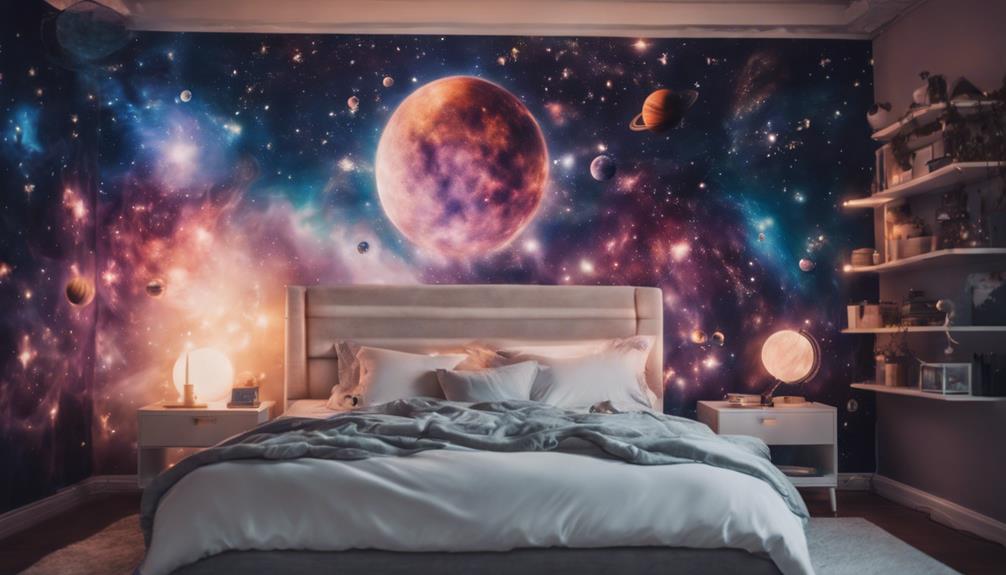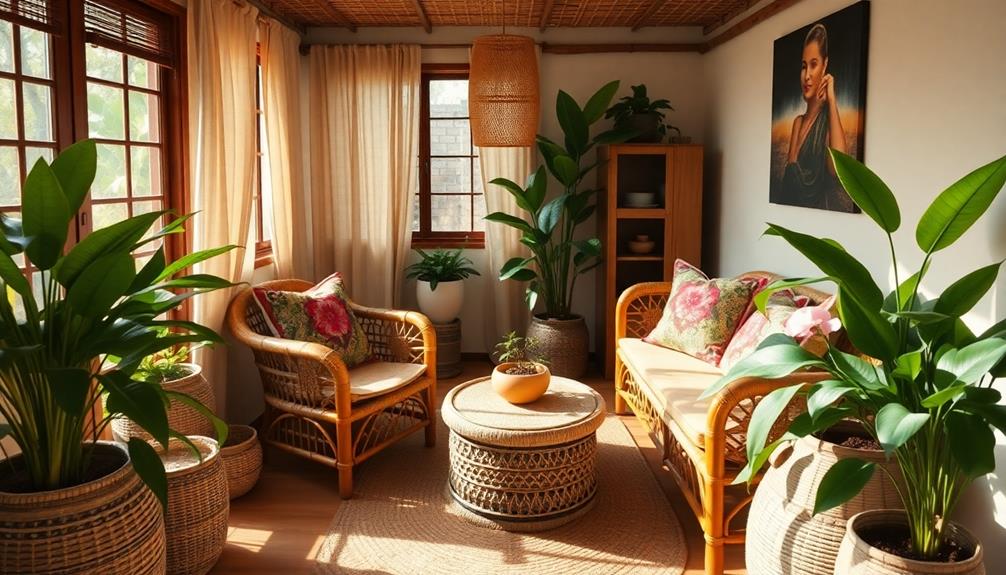Indonesian interior design, especially influenced by Balinese styles, charms with its traditional craftsmanship and natural elements. You'll notice the use of materials like wood and rattan that create warmth. Open layouts enhance ventilation, allowing natural light to flow through. Earthy tones dominate the palette, complemented by vibrant accent colors that express meaning. Intricate carvings and cultural artifacts enrich spaces while supporting local artisans. Sustainability is key, focusing on eco-friendly materials and preserving the environment. With such a blend of aesthetics and nature, you'll discover how these elements create harmony in living spaces and much more awaits your exploration.
Key Takeaways
- Emphasis on natural materials like wood, stone, and bamboo creates warmth and authenticity in living spaces.
- Open-air layouts enhance ventilation and connection with nature through large windows and sliding doors.
- Earthy tones combined with vibrant accents reflect Indonesia's landscapes and cultural significance.
- Incorporation of cultural artifacts and traditional textiles adds depth and showcases local craftsmanship.
- Commitment to sustainability through eco-friendly materials and locally sourced resources promotes environmental responsibility.
The Rise of Balinese Design

The allure of Balinese design has captivated many, transforming living spaces into serene retreats that celebrate Indonesia's rich cultural heritage. Emerging in the early 1990s, this design style gained global recognition largely due to the influence of Indonesian architect Made Wijaya. He emphasized traditional elements that resonate with the soul of Bali, creating spaces that prioritize natural materials and sustainable practices.
Balinese design seamlessly incorporates natural materials like wood, stone, bamboo, and rattan. These materials create a warm, grounded atmosphere in your home, inviting you to connect with nature. You'll find that open floor plans are a hallmark of this style, effectively blurring the boundaries between indoor and outdoor spaces. This not only enhances natural ventilation and light but also fosters a sense of harmony with the environment.
The aesthetic appeal of Balinese interiors lies in their intricate carvings and a rich color palette featuring earthy tones complemented by vibrant accents. This design philosophy focuses on comfort and tranquility, making it a popular choice for those seeking refuge from the hustle and bustle of everyday life.
Today, Balinese design continues to be celebrated worldwide, embodying a unique blend of culture, comfort, and beauty that resonates with many.
Key Features of Balinese Interiors

Engaging elements define Balinese interiors, making them both inviting and harmonious.
You'll find that these interiors beautifully blend natural materials with traditional craftsmanship, often enhanced by expert tropical design principles that focus on functionality and aesthetic appeal.
Here are some key features that stand out:
- Natural Materials: Balinese homes prominently use wood, stone, bamboo, and rattan, creating a warm and grounded atmosphere in your living spaces.
- Intricate Carvings: Hand-carved wooden furniture, often made from durable teak, showcases the artistry of traditional Balinese craftsmanship, adding character to your home.
- Open-Air Layouts: The design emphasizes open-air layouts that blur the lines between indoor and outdoor spaces, enhancing ventilation and fostering a deeper connection with nature.
- Serenity with Nature: Incorporating water features and lush tropical greenery is common, promoting tranquility and enhancing the peaceful ambiance that characterizes Balinese design.
Color Schemes and Aesthetic Appeal

Color schemes play an essential role in creating the unique aesthetic appeal of Indonesian interiors, inviting warmth and vibrancy into your home.
You'll often find a mix of earthy tones, like brown, beige, and green, which ground the space and evoke a sense of nature. These hues create a calming backdrop that allows vibrant colors—such as red, gold, orange, and turquoise—to shine through, adding cultural flair and energy.
Incorporating traditional textiles like batik and ikat in your upholstery and decor not only enhances visual interest but also strengthens your cultural identity, as seen in Indonesian decorative pillows that bring comfort and style. The rich wood tones of mahogany and teak contribute warmth and authenticity, while intricately carved furniture further elevates the aesthetic.
Colors also carry significant meanings; for instance, white symbolizes purity and balance, while black represents wisdom. By thoughtfully selecting your color schemes, you'll promote a harmonious atmosphere that reflects the essence of Indonesian design.
The functional layouts encourage seamless flow between spaces, ensuring comfort and inviting natural light, which enhances the overall aesthetic appeal of your home.
Embrace these elements, and you'll create a stunning environment that celebrates Indonesia's rich culture.
Nature-Inspired Design Elements

Incorporating nature-inspired design elements can transform your Indonesian interior into a serene oasis that reflects the surrounding environment. By using organic materials and vibrant greenery, you can create a warm, inviting space that resonates with the beauty of nature.
To further enhance your decor, contemplate adding unique pieces like a Face Indonesian Decor Mask to celebrate the rich cultural heritage. Here are some key elements to reflect upon:
- Natural Materials: Incorporate wood, stone, bamboo, and rattan to create a grounded atmosphere. These materials add texture and warmth to your interiors.
- Tropical Greenery: Use indoor plants like palms and ferns to purify the air and add a lush touch. They not only enhance aesthetics but also strengthen your connection to the outdoors.
- Water Features: Integrate ponds or fountains to evoke tranquility. The soothing sounds of flowing water can greatly enhance your living space's ambiance.
- Earthy Tones: Utilize colors like browns, beiges, and greens to reflect Indonesia's landscapes. Add vibrant accents in red, gold, or turquoise for cultural flair while maintaining a natural vibe.
Emphasizing Open Spaces

Emphasizing open spaces in your Indonesian interior design creates a revitalizing atmosphere that invites nature indoors. By incorporating large windows and sliding doors, you can blur the boundaries between your indoor and outdoor environments, maximizing natural light and fostering a rejuvenating ambiance.
This seamless connection not only enhances air circulation but also allows you to enjoy the lush landscapes typical of the region, promoting a relaxed atmosphere suitable for social gatherings, as seen in traditional Indonesian style home decor.
Utilizing open floor plans encourages free movement throughout your living areas, providing unobstructed views that contribute to a sense of spaciousness and tranquility.
Balinese architecture highlights the importance of integrating nature-inspired elements, such as water features and tropical greenery, into these open spaces. This connection to nature evokes a serene and calming environment, perfect for relaxation.
Cultural Artifacts and Textiles

The vibrant patterns and textures found in traditional Indonesian textiles and cultural artifacts play a significant role in defining the character of your interior space. By incorporating these elements, you not only enhance the aesthetic appeal but also connect to Indonesia's rich heritage.
Indonesian decor masks are a striking example of how cultural artifacts can enrich your home. Here are some ways to integrate these stunning features into your design:
- Batik Patterns: Use batik fabrics in upholstery or curtains. Their intricate designs can create a focal point in any room.
- Ikat Fabrics: Add ikat textiles to cushions or throws. These unique, blurred patterns bring depth and visual interest to your furnishings.
- Cultural Artifacts: Decorate with traditional masks or wood carvings. These pieces serve as conversation starters and storytelling elements that reflect local craftsmanship.
- Handcrafted Items: Incorporate artisan-made decor. These items enrich your space while fostering a connection to the cultural narratives that define traditional Indonesian design.
Sustainability in Indonesian Design

Sustainability is at the forefront of Indonesian interior design, as designers embrace eco-friendly materials like rattan and bamboo. These sustainable options have a considerable lower environmental impact than synthetic alternatives, making them a preferred choice.
With Indonesia accounting for 80% of the world's rattan enterprises, producers prioritize sustainable harvesting practices that protect the ecosystem while providing versatile materials for furniture and decor. Additionally, the influence of traditional Indonesian housing styles often inspires the design elements, incorporating distinct regional aesthetics that reflect cultural identity and heritage traditional housing styles.
You'll find that many designers focus on utilizing locally sourced materials, which helps reduce carbon footprints and promotes regional craftsmanship. This commitment to sustainability doesn't just stop at materials; it extends to traditional techniques.
By incorporating methods like batik and wood carving, designers support artisan communities, ensuring that cultural heritage thrives alongside eco-friendly practices.
Moreover, there's a growing awareness within the interior design community about energy efficiency. Designers are maximizing natural light and ventilation in their projects, creating living spaces that aren't only aesthetically pleasing but also environmentally responsible.
As you explore Indonesian interior design, you'll see how sustainability, eco-friendly materials, and traditional techniques blend harmoniously to create beautiful, responsible living spaces.
Frequently Asked Questions
What Are the 7 Elements of Interior Design?
The seven elements of interior design are space, line, form, light, color, texture, and pattern. Each element shapes your environment, enhancing both the aesthetic appeal and functionality of the spaces you create.
What Is the Balinese Design Element?
Balinese design elements emphasize natural materials like wood and stone, creating a serene atmosphere. You'll appreciate open-air spaces that blend indoors and outdoors, intricate carvings, and vibrant textiles that reflect rich cultural artistry.
How to Make Furniture Look Balinese?
To make furniture look Balinese, incorporate hand-carved wooden pieces, use natural materials like bamboo, and choose upholstery featuring traditional textiles. Opt for organic shapes and multifunctional designs to enhance harmony and connection with nature.
What Are the 5 Elements of Interior Design?
The five elements of interior design are space, line, form, texture, and color. You can enhance any room by thoughtfully arranging these elements to create a cohesive, inviting, and aesthetically pleasing environment that reflects your style.
Conclusion
Incorporating Indonesian interior design elements into your space not only enhances its aesthetic but also connects you to a rich cultural heritage. As the saying goes, "Home is where the heart is." By embracing Balinese design, nature-inspired aesthetics, and sustainable practices, you create a sanctuary that resonates with warmth and harmony. So, let the vibrant colors, open spaces, and unique artifacts reflect your personality and values, turning your home into a true reflection of your spirit.









